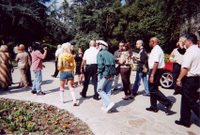Let me offer this disclaimer: I'm a huge fan of this show. Life on earth isn't good enough for me so I've adopted another universe to live in. Tonight's event was a special screening of the mid season finale (I'll never get used to that phrase) of Battlestar Galactica: The Eye of Jupiter. Special because the episode was screened in a movie theater a day before its scheduled airing on TV.
Let me also say that I have no industry connections or studio perks. I signed up for the ticket lottery off
www.scifi.com and stood on line for 2 hours to get a seat. You have to understand, I get impatient if I'm in my doctor's waiting room for more than 10 minutes. [for the record, I was the guy who asked 'was it different with an audience?' at the Q&A]
If you've read any blurb about this episode (and this will be moot within 24 hours), there is not much more I can add here plotwise. After all (and please don't be shocked) it is the first part of a two parter so there isn't any great revelation other than nuclear weapons will be involved.
In attendance (forgive me, I couldn't hear all their names and don't recognize the staff by sight) were writers David Weddle, Michael Taylor,
Jane Espensen, Mark Verheiden, and Anne Cofell Saunders. What was gratifying was that the sole ovation during the opening credits went to the writer of the episode, Mark Verheiden (if writers were musicians, he'd be a rock star).
Battlestar Galactica is one of the few shows I watch in real time even though I have a DVR (not Tivo, but a p.o.s. Moxie). Normally I enjoy it with a beer in one hand and a burger in the other. Tonight was communal. We laughed at the jokes (and maybe at a few things that weren't intended to be funny-- 'Algae Planet'? I guess all the good names were already taken), we gasped when Starbuck's raptor went down and we all screamed when "to be continued" flashed on the screen. The theatrical experience was different from the television experience.
I don't mean different in just the banal difference between sitting at home and sitting in a theater. There was something different about this experience. With Edward James Olmos' face towering 20 ft high and seeing every pock on his cheek, suddenly every intimacy took on mythic proportions.
I wondered if I had felt the same way with Kirk, Picard, Mulder and Scully, and Malcolm Reynolds: characters embodied by the same actors on both the small and big screens. The story of this episode was 'big' enough to fill that cinema screen unlike some of the Star Trek sequels. That's not a snipe at Star Trek by any means.
We the audience didn't want the Star Trek universe to surprise us as much as let us relive the glory days, like an aging rock band that can't leave the stage until they play all their hits. We had come to expect certain things from a Star Trek yarn and were disappointed if we didn't get them all. The characters had lost their capacity to surprise us and became cliches.
When I said 'big' up above, I mean that the episode showed me something I hadn't seen before, at least not in the Battlestar Galactica universe. Will Adama sacrifice Lee, Kara and the Eye of Jupiter? Of course not because we know that would be the effective end of the series. How Adama will get out of this dilemma, I haven't a clue... but what is joyful to me is that because the show is still young, I don't know what the 'Battlestar Galactica' solution would be.
Let me put this in a Star Trek context. Kirk led a charmed life and would bluff or use cowboy diplomacy (The Corbomite Maneuver) to win the day. Or our intrepid crew would utilize some obscure science or technical wizardry to gain the upper hand (any episode using the transporter). We want to see Kirk being Kirk because we take comfort in that.
What made The Wrath of Khan so shocking was that with the death of Spock, the Star Trek universe suffered a real loss for the first time and it changed Kirk. We saw something new in his character. However, once Spock conquered death then really, how do you define 'loss' in this or any science fiction/fantasy universe anymore? By forfeiting any sense of real danger, all the subsequent Star Trek sequels suffered from the lack of any true dramatic tension.
Did Malcolm Reynolds do anything in Serenity we didn't see him do in Firefly? Did Mulder and Scully do anything in the film version of X-Files that we hadn't seen them do hundreds of times during the series?
The James Bond franchise suffered from the same malaise. Not only did we know James Bond would win the day, he was smug and glib about it. What made Daniel Craig's Bond so refreshing was that he truly was a 'blunt instrument'; that he shared the audience's sense of 'oh shit, what's going to happen now?' He allowed himself to be fooled, betrayed and outsmarted. He didn't have an answer for everything and he paid a price.
Perhaps that also might be my biggest complaint about movies in general is that for all the big budgets and splashy casts, they have lost the capacity to surprise. I suspect it's because we've become slaves to the three act/Hero's Journey structure which is now used to mitigate financial risk at the expense of artistic risk. Even so-called 'indie' movies have smoothed their rough edges either by design or by process because they have to appeal to a large audience to make back their nut.
By taking a television series episode (which is the definition of 'same, but different') and magnifying it on the big screen, the overused story muscles and go-to plot devices would become apparent. But despite having seen every episode and analyzed more than a few, I've noticed that BSG has rarely repeated itself.
So far, there are few things sacred about the Battlestar Galactica canon. That's good. 'Adama being Adama' has no meaning because we don't yet know all there is to know about him.
And as long as the exploration of the characters has the capacity to astonish, disgust and delight us, that as long as 'Adama being Adama' or 'Baltar being Baltar' has no meaning, and as long as the surprises outnumber the cliches, Battlestar Galactica has a welcome home on any screen.








